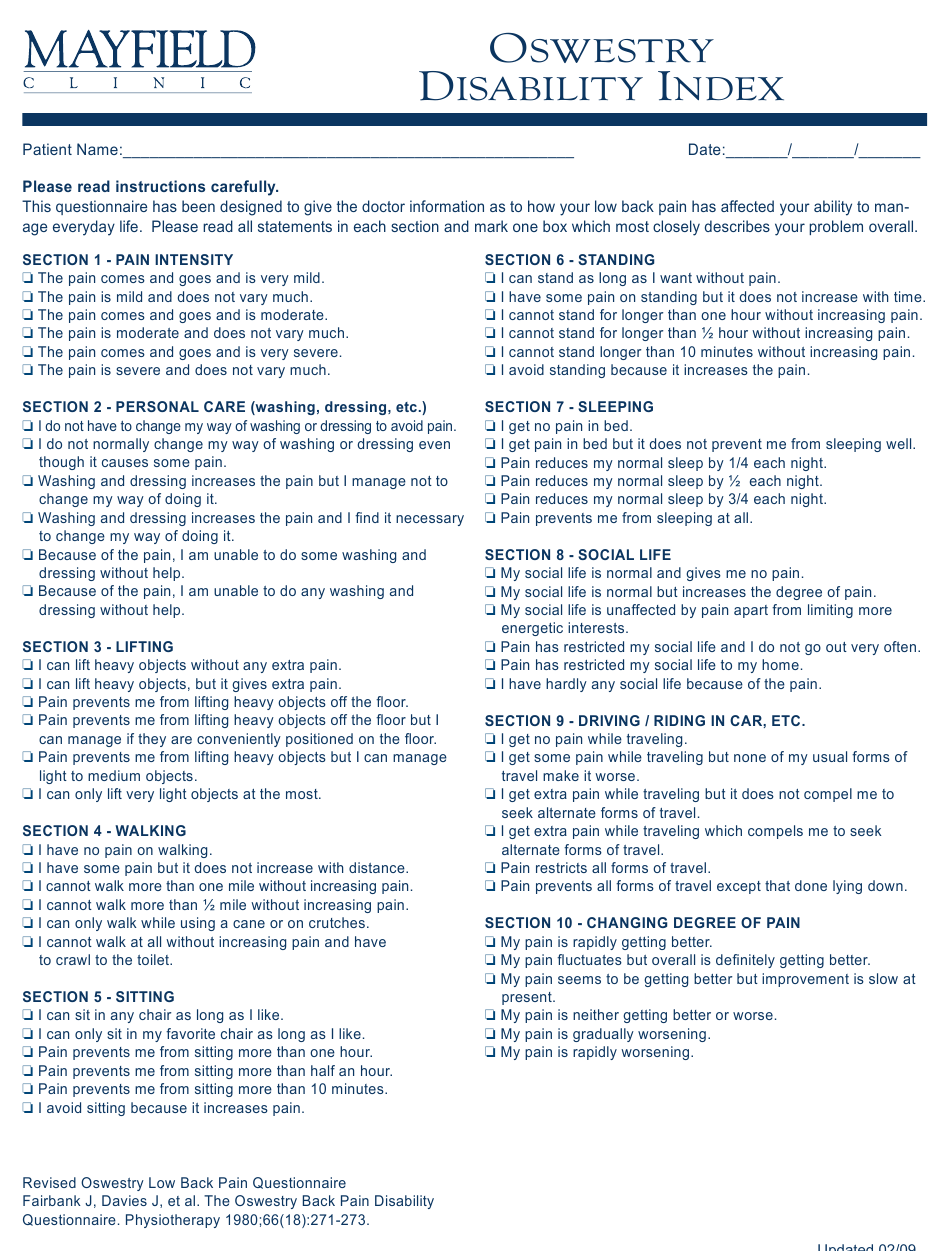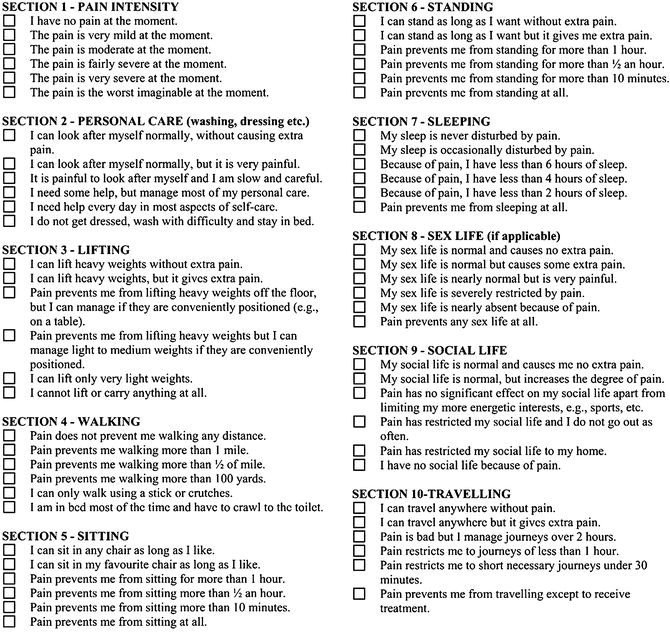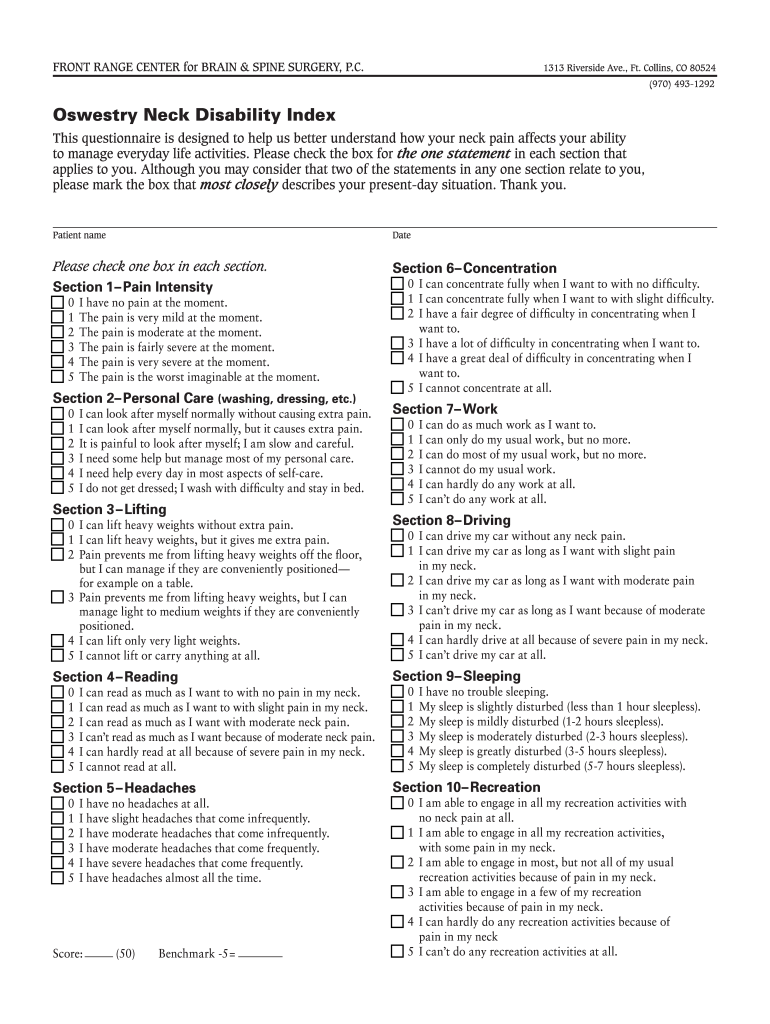Receiver Operator Characteristic Curves
Receiver operator characteristic curves, used in the context of considering the responsiveness of change scores in an instrument or scale between two time points, investigate the sensitivity and specificity of the change scores in comparison with an external gold standard or criterion of important change .
This means that sensitivity is defined as the number of subjects correctly identified as undergoing important change by a particular scale or instrument and specificity is the number of subjects correctly identified as not having important change. Of note is that important change can be defined by both the patient/client and the therapist. The area under the curve represents the probability of correctly identifying the improved subject from a randomly selected group of improved and unimproved subjects . A ROC curve can be presented for varying cut-off points.
Davidson and Keating compared the responsiveness of the
Daniel C. Lu, Kevin T. Foley, in, 2012
Oswestry Disability Index Questionnaire
If youre a patient dealing with back or leg pain that affects you daily, you should fill out the questionnaire so your doctor can assess you better. Within the 10 sections, you select one of the six statements that best describes your situation. Although there might be two or more statements that you believe apply to you, select the one that best describes your issue. These 10 sections cover:
For each of these sections, you choose from the following statements:
Which Rating Scales Are Useful To Measure The Patient’s Degree Of Disability And Responses To Treatment
The Roland-Morris Disability Questionnaire , Oswestry Disability Index , and Sickness Impact Profile are three popular instruments that have been employed both for research and clinical assessment. Collectively, these instruments assess the patient’s ability to engage in everyday activities: sleep and rest, eating, work, home management, recreation and hobbies, ambulation, mobility, body care and movement, social interaction, alertness behavior, emotional behavior, and communication. Readministration of the chosen instrument will yield change scores that can be used to measure improvement or deterioration, as well as responsiveness to treatment.
Julie Fritz PT, PhD, ATC, in, 2012
You May Like: What Does Non Medical Disability Mean
Goodness Of Fit And Collinearity
A Nagelkerke R2 was used to assess goodness of fit, as it theoretically represents the proportion of variance in the criterion that is explained by the predictors. The Nagelkerke R2 is a version of the Cox and Snell R2, which overcomes the problem that this statistic has of not being able to reach its maximum value. Although controversial, the Nagelkerke R2 is often used to determine how well the predictors explain the model variance . The R2 was run for each of the six models.
Collinearity is a measure of the correlation between the predictive variables in the model. Collinearity is usually measured in terms of variance inflation factors for their predictors. Variance inflation factors were calculated for each covariate in all six models. Ideally, VIF values should be low with a mean VIF close to 1, indicative of minimal collinearity, cut-offs of 5, 10, and sometimes 30 have been suggested as indicating problematic levels of multicollinearity.
What Is The Best Treatment For Lower Back Strain

Treatment: Treatments for lower back strain may include giving your back a rest and taking medications that treat muscle spasm. Applying heat applications and massaging the painful area can also aid in treating lower back strain. Besides, reconditioning exercises can strengthen the lower back muscles.
Recommended Reading: Partially Blind Means
One Of The Most Common Patient
The ODI is comprised of 10 questions. The questionnaire asks patients about their ability to manage everyday life and covers intensity of pain, lifting, the ability to care for oneself, ability to walk, the ability to sit, sexual function, ability to stand, social life, sleep quality, and ability to travel. Answers are then scored on a 0-5 scale, zero meaning no disability.
The final score/index ranges from 0-100. A score of 0-20 reflects minimal disability, 21-40 moderate disability, 41-60 severe disability, 61-80 crippled, and 81-100 bed-bound. A minimal clinical difference has been evaluated across numerous types of spinal surgery and has been shown to vary significantly however, it is generally agreed that 10-12 points result in meaningful patient improvement.
Get the Guide – Spine PRO Measures
Included you’ll find an unbiased evaluation of the strengths and considerations of the most popular Spine PRO measures. Download Now.
Modified Oswestry Disability Questionnaire
The two most commonly used self-report disability scales are the Modified Oswestry Disability Questionnaire and the Roland Morris Questionnaire.47 We have used the Oswestry questionnaire for the purposes of staging patients and assessing the outcomes of treatment. The Oswestry questionnaire has 10 sections: 1 section for pain severity and the other 9 representing various functional activities . The patient indicates the degree of limitation in that activity because of LBP. Each section contains six responses, scored from 0 to 5. Each section score is summed to obtain the final score. The final score is then multiplied by 2, and the degree of disability is expressed as a percentage. Higher scores on the Oswestry questionnaire indicate greater levels of perceived disability.48 The Oswestry score can assist in staging the patient. Generally, patients in stage I will have Oswestry scores at or greater than 30%, and patients in stage II will have scores lower than 30%.
Michael A. Foy, in, 2010
You May Like: Is Celiac Disease A Disability Under The Ada
What Is Neck Disability Index
The Neck Disability Index is a 10-item questionnaire that measures a patient’s self-reported neck pain related disability. … A higher NDI score means the greater a patient’s perceived disability due to neck pain. The minimally clinically important change by patients has been found to be 5 or 10%.
What Is The Oswestry Disability Index
Also known as the Oswestry Low Back Pain Disability Questionnaire, the Oswestry Disability Index helps to measure a patients lower back pain. It evaluates the extent to which the patients level of function is restricted by the pain, concentrating on the effects rather than the nature of the pain. Considered by many clinicians and researchers as the gold standard for determining the degree of disability and estimating the quality of life for those experiencing back pain, the 10-question survey contains topics relating to pain intensity, daily activities, and sleep quality.
Recommended Reading: Disability For Bulging Disc
More Information On Translations
Bibliographic references of the translations:
Arabic:Guermazi M, Mezghani M, Ghroubi S, Elleuch M, Med AO, Poiraudeau S, Mrabet F, Dammak J, Fermanian J, Baklouti S, Sellami S, Revel M, Elleuch MH. Ann Readapt Med Phys. 2005 Feb 48:1-10. French
Cantonese for Hong-Kong:Law KKP, Lee PL, Kwan WW, Mak KC, Luk KDK. Cross-cultural adaptation of Cantonese Oswestry Disability Index version 2.1b. Eur Spine J. 2021 Sep 30:2670-2679
Chinese:Chow J, Chan C. Validation of the Chinese version of the Oswestry Disability Index. Work. 2005 25:307-14
Liu H, Tao H, Luo Z. Validation of the simplified Chinese version of the Oswestry Disability Index. Spine . 2009 May 15 34:1211-6 discussion 1217
Lue YJ, Hsieh CL, Huang MH, Lin GT, Lu YM. Development of a Chinese version of the Oswestry Disability Index version 2.1. Spine . 2008 Oct 1 33:2354-60
Ma C, Wu S, Xiao L, Xue Y. Responsiveness of the Chinese version of the Oswestry disability index in patients with chronic low back pain. EUR SPINE J. 2011 20:475-81
Croatian:Domazet I, Nemir J, Barl P, uri KS, Paali I, Bari H, Stani M. Validation of the Croatian version of the Oswestry Disability Index. Eur Spine J. 2018 Nov 27:2814-2822
Czech:Vaculik J, Toth L, Trnovsky M. Acta Chir Orthop Traumatol Cech. 2003 70:89-94. Czech
Dutch for the Netherlands:van Hooff ML, Spruit M, Fairbank JC, van Limbeek J, Jacobs WC. The Oswestry Disability Index : validation of a Dutch language version. Spine . 2015 Jan 15 40:E83-90
History Of The Oswestry Disability Index
In 1976, John OBrien developed the Oswestry Disability Index after he interviewed patients suffering from back pain. He compiled a range of questions based on his research, and the final version of the questionnaire was published in 1980 in Physiotherapy by Dr. Jeremy Fairback, who was a professor of spinal surgery at the Nuffield Department of Orthopaedics, Rheumatology, and Musculoskeletal Sciences in Oxford, England. Over time, the questionnaire has been revised, with the latest version published in 2000.
Don’t Miss: Disability Universal Studios
The Oswestry Low Back Pain Disability Questionnaire
The Oswestry Low Back Pain Disability Questionnaire49 is the oldest and most thoroughly researched instrument designed to assess functional status and disability.45,50,51 A strength of the Oswestry is that it possesses strong psychometric properties and has been thoroughly investigated.49,5260 Moreover, a number of studies have shown the Oswestry to be a very responsive self-report instrument in detecting clinically meaningful change.50,6166 A possible weakness of the Oswestry, though, are studies suggesting a possible floor effect, such that extremely low scores may not be as accurate as more moderate or high scores.50,52,67 Also, as noted by Kopec,52 the majority of currently available disability indices focus primarily on the physical activities of daily living, with only minimal attention given to psychosocial concerns. In fact, no items on the Oswestry directly inquire about one’s emotional or psychological state, despite the fact that research has indicated that psychological factors play an integral role in the development and maintenance of disability.68,69
Dale A. Halfaker PhD, … Ted L. Wunderlich BA, in, 2011
Is Powys A Nice Place To Live

A Powys town has been named as one of the best places to live in Britain. That’s according to the Sunday TImes which has named 10 locations in Wales in its annual Best Places to Live in Britain guide. … Only Abersoch, Monmouth and Penarth, made it onto the list again this year from last year’s Welsh entrants.
Recommended Reading: Neuropsychological Impairments
Scoring Guide For The Oswestry Low Back Pain Disability Questionnaire
Scoring instructions
For each section the total possible score is 5: if the first statement is marked the section score = 0 if the last statement is marked, it = 5.
If all 10 sections are completed the score is calculated as follows: Example: 16 50 x 100 = 32% If one section is missed or not applicable the score is calculated: 16 45 x 100 = 35.5%
Minimum detectable change : 10% points
Interpretation of Scores
0% to 20%: minimal disability: The patient can cope with most living activities. Usually no treatment is indicated apart from advice on lifting sitting and exercise.
21%-40%: moderate disability: The patient experiences more pain and difficulty with sitting, lifting and standing. Travel and social life are more difficult and they may be disabled from work. Personal care, sexual activity and sleeping are not grossly affected and the patient can usually be managed by conservative means.
41%-60%: severe disability: Pain remains the main problem in this group but activities of daily living are affected. These patients require a detailed investigation.
61%-80%: crippled: Back pain impinges on all aspects of the patient’s life. Positive intervention is required.
81%-100%: These patients are either bed-bound or exaggerating their symptoms.
Is Oswestry A Nice Place To Live
“Oswestry is a small community and a very close-knit one,” he says. “It’s a wonderful place to live, but the population is growing and the infrastructure needs to grow as well. “People want to move to this area because it’s a lovely place to live, but you need to provide them with services.”10 aug. 2016
Recommended Reading: Gaf Score Of 60
How Is The Pain Disability Questionnaire Scored
The items of the questionnaire are assessed on a 010 numeric rating scale in which 0 means no disability and 10 is maximum disability. The sum of the seven items equals the total score of the PDI, which ranges from 0 to 70, with higher scores reflecting higher interference of pain with daily activities.
Minimal Clinically Important Difference Scores Used For The Odi During Creation Of The Predictive Models
The modified version of the ODI was used for this study. Within the modified version, the sex-related question was replaced with a question associated with social life. Six MCID cutpoints were used in constructing the predictive models. These included:
a 50% change in disability from the initial to final ODI calculated as 50%
a 30% change calculated as 30% change 30% ,
a 17-point decrease calculated as 17-point change 17
a 10-point decrease calculated as 10-point change 10 ,
a 56-point decrease calculated as 56-point change 5 ,,
a final ODI score of 20% or less.
Don’t Miss: Qualifications For Ssi In Texas
Introduction To The Oswestry Disability Index
The Oswestry Disability Index was pioneered by John OBrien in 1976 and was developed following patient interviews which focused on low back pain. In 1980, OBrien et al. published an initial version of the questionnaire, which has since been modified several times to date.1,2 The ODI is now a widely used questionnaire for assessing functional status and quality-of-life impairment in patients with low back pain or spinal cord disease and injury in research and clinical settings.3 6 The most current version of the ODI is version 2.1.a. which is designed to provide information on how back pain affects patients ability to manage everyday activities.3
Implementation Of The Eq
The ODI is short , quick to evaluate, and thus comparatively easy to use in the clinic. It has been extensively tested for sensitivity, validity, and reliability in various clinical settings and has demonstrated good psychometric properties.5, 6 It is now a widely used index for the assessment of low back pain.11 It has also been implemented in registries such as the spine registry of the German Spine Society.12
Many different ODI versions have been used in the literature over the years, some of them modified, unauthorized versions. These are rarely specifically identified, which limits comparability, especially with older studies.13 In addition, question 8 is often omitted by patients.14
The ODI is under copyright and a license must be applied for. For students, physicians, non funded academic users and for clinical implementation, use of the ODI is free. Funded academic users, commercial users and IT companies must apply for a license and incur costs.4Our PRO consultants happily provide more in-detail information.
Don’t Miss: How Is Disability Calculated In California
Convergent And Discriminant Validities
To test the convergent validity of the unidimensional model of the ODI, we conducted confirmatory factor analysis with the lavaan and matrixpls packages . If the composite reliability is greater than 0.7 and the average variance extracted greater than 0.5, then the convergent validity is confirmed . The cutoffs of model fit statistics are as follows: the root mean square error of approximation < 0.06, the close fit test that was non-significant , the standardized root mean square residual 0.05, the weighted root mean square residual < 1.0, the comparative fit index 0.95, and the Tucker-Lewis index 0.95 .
To test the discriminant validity of the ODI, we used the Fornell-Larcker criterion and the heterotrait-monotrait ratio with the PCS and MCS of the SF-36 . As for the Fornell-Larcker criterion, if the AVE of the ODI is larger than the squared correlations between the ODI and the PCS and MCS of the SF-36, then the discriminant validity of the ODI is confirmed. As for the HTMT ratio method, two criteria of discriminant validity are as follows: the HTMT ratio should be less than 0.85 , and the 90% normal bootstrap confidence should not include 1 . We got the corresponding 95% confidence intervals of CR, AVE, and HTMT ratios of the ODI with 10,000 bootstrap replications .
How To Score The Oswestry Disability Index

Each section in the questionnaire has a total possible score of five. If the first statement is marked, the score is zero. If the last statement is marked, the score is five. Add up your score from all 10 questions and divide that number by the total possible score.
For instance, if you scored 17 points in all 10 sections, the equation would be: 17 / 50 x 100 = 34%.
However, if you answered questions in only nine sections, the equation would be: 17 / 45 x 100 = 38%.
If you score 0%, you have no disability, while a score of 100% indicates a maximum disability. Remember that its best to round the percentage to a whole number to better understand where you fall within the results.
Read Also: What Gaf Score Is Considered Disabled
Reasoning Discussion And Clinical Reasoning Commentary
1 You administered a MOQ as part of your examination and following the patient’s referral to a rheumatologist. What particular information were you seeking with this test and how did you use that information? Do you use it instead of asking certain questions in the subjective examination?
Clinicians answer
The MOQ was administered in part to gather information in lieu of asking questions during the subjective examination, and in part to assess the patient’s progress after being treated by the rheumatologist. A comparison of the initial and follow-up MOQ results also gave an insight into which activities were still difficult for the patient to perform and which activities were now easier. This information helped to guide the physical examination at each appointment.
2 Many practitioners would be tempted to categorize a patient with a 13-year history of LBP as beyond physical intervention and requiring psychological management. What led you to pursue a physical diagnosis despite the failure of numerous clinicians in the past?
Clinicians answer
In the end, this patient could be diagnosed. Perhaps it took time for his pattern of limited motion to emerge to the point where it was recognizable. It is likely, however, that in the past this patient offered clues as to his underlying condition that went unnoticed.
Clinical reasoning commentary
Dennis Thornton PhD, Charles E. Argoff MD, in, 2009
